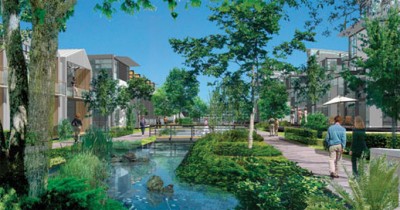Green building 201: Water

Green buildings to the people reading this website is like buildings with four walls and a ceiling to the general population. So, it’s time to take a look at more advanced specifics of green building, especially with what is becoming less and less of a commodity: water. For instance, flying over Vegas last week for the ULI conference, one can easily see that that its main water supply, Lake Mead is down 100 feet and now only at half capacity. Coincidentally, the ULI is the source for this story, “Is Water the Next Carbon?.
Of course, halting new development is the most effective means of limiting water use, but until population growth halts altogether, here are efforts to make future destinations blue (smaller water footprint) as much as it is green (smaller carbon footprint).
On a country and master development level: Australia, the world’s driest inhabited continent, established Water for a Healthy Country Flagship, which is investing in four model projects that demonstrate progressive water stewardship. One of those, the Wungong Urban Water Project, has the following goals to reduce water usage by 45-75%:
– minimizing the overall consumption of water in the Wungong project;
– reducing traffic impact on the local water system;
– using water-sensitive urban design;
– minimizing water requirements for heating, cooling, lighting, and energy;
– protecting waterways and wetlands;
– maximizing biodiversity and native landscapes;
– recycling water; and
– encouraging water efficiency in buildings.
On a development level: Dockside Green is a 15-acre community on a former industrial site adjacent to downtown Victoria, British Columbia, Canada. Potable water use will be 60-65% lower through:
– low-flow fixtures and reclaimed water for toilets;
– self-monitoring of hot and cold water usage via individual meters;
– all sewage water being treated on site and reused primarily for toilets, landscape irrigation, and water features;
– access for all businesses to recycled water for nonpotable uses.
– a recycled water system supporting Dockside Creek, a scenic waterway that plays a key role in stormwater management (pictured).
Real projects that set new progressive benchmarks often make a larger impact than comprehensive (ie ‘watered-down’) policy.

Leave a Reply